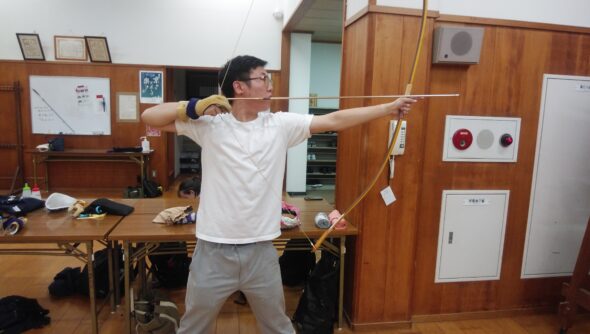 For my CIP this semester, I chose to take lessons in Kyudo, the traditional martial art of archery. I had practices at the Kyoto City Budo Center once or twice a week, and I was instructed by Furuya-sensei, a very kind teacher who has taught KCJS students in the past as well. I have actually been interested in Kyudo for a long time, and I’ve done archery before at a club at my home university, but as Kyudo is a very different kind of activity, I wanted to really learn it from the ground up while I had the rare chance to here in Kyoto. Kyudo is different from regular archery primarily in its objective. Rather than focusing on the particular result of hitting a target accurately, Kyudo emphasizes the form of the process itself, from stepping into the range to drawing the bow and everything in between. The idea is that the shooter focuses not on hitting the target, but completes every defined movement naturally and beautifully with an empty mind, and thus the arrow will always strike its target as a byproduct of one’s consistent efforts. I had an incredible time learning this difficult but rewarding art, and I would encourage anyone even remotely interested to give it a shot. A piece of advice I would give to beginners would be to not go into it with any expectations of yourself, as regardless of your previous experience with archery or other martial arts, you will almost certainly have to learn everything from the ground up, as there are just so many minute details about Kyudo. But should you be willing to fail over and over again until your body has remembered every specific movement and posture, I can guarantee that the feeling of gratification you’ll get when you finally hit the target is like no other.
For my CIP this semester, I chose to take lessons in Kyudo, the traditional martial art of archery. I had practices at the Kyoto City Budo Center once or twice a week, and I was instructed by Furuya-sensei, a very kind teacher who has taught KCJS students in the past as well. I have actually been interested in Kyudo for a long time, and I’ve done archery before at a club at my home university, but as Kyudo is a very different kind of activity, I wanted to really learn it from the ground up while I had the rare chance to here in Kyoto. Kyudo is different from regular archery primarily in its objective. Rather than focusing on the particular result of hitting a target accurately, Kyudo emphasizes the form of the process itself, from stepping into the range to drawing the bow and everything in between. The idea is that the shooter focuses not on hitting the target, but completes every defined movement naturally and beautifully with an empty mind, and thus the arrow will always strike its target as a byproduct of one’s consistent efforts. I had an incredible time learning this difficult but rewarding art, and I would encourage anyone even remotely interested to give it a shot. A piece of advice I would give to beginners would be to not go into it with any expectations of yourself, as regardless of your previous experience with archery or other martial arts, you will almost certainly have to learn everything from the ground up, as there are just so many minute details about Kyudo. But should you be willing to fail over and over again until your body has remembered every specific movement and posture, I can guarantee that the feeling of gratification you’ll get when you finally hit the target is like no other.
「The University of Chicago」カテゴリーアーカイブ
Jason Gonzalez: Kyokushin Karate
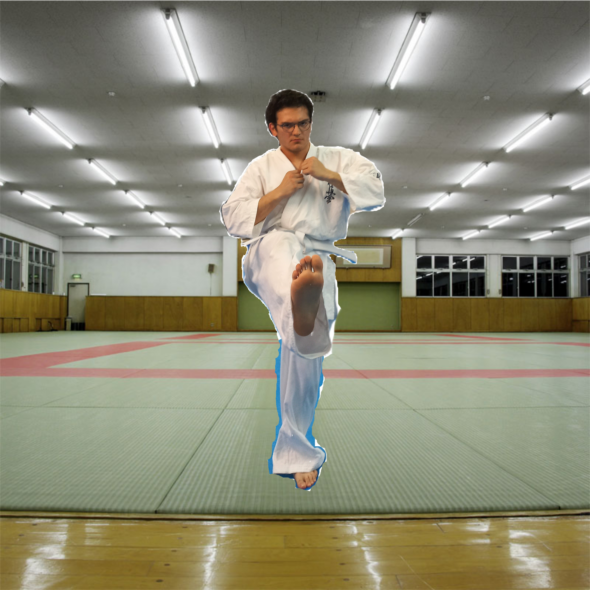
(Edited image as I could not post a photo of the dojo itself)
Kyokushin Karate is a full-body contact sport (advanced training/real matches will involve you getting hit) pioneered by Masutatsu Oyama, which focuses on how gracefully your movements flow into one another but also on the power of your strikes. Moves include punches and kicks, along with blocks/deflects, prioritizing a strong body and sharp mind rather than utilizing evasive tactics.
The sensei was understanding given that it was my first time doing karate and it took me a few weeks (1 practice a week) to learn the basics, and I found that the dojo is considered a sacred but welcoming place with students from all walks of life gathered for the purpose of learning. I chose this activity to supplement my workout routine and to challenge myself in a completely new environment (karate in Japan) which normally requires you to pay close attention and listen to the instructor to do techniques correctly, but now I had to learn new Japanese phrases as well to follow along.
I have several pieces of advice, the first being to practice what you learned on your own time, even for just a bit. Returning to the dojo can be the hardest part as you don’t want to make the same mistakes as before, so practice the basics on your own time to iron out the form and be ready for the upcoming lesson. Here’s a useful link for the basics: (https://youtu.be/2_PRuRqbSLo?feature=shared)
REMEMBER, stretch first. Secondly, learn how to tie your dogi properly, it’s a sign of how prepared you really are, and it prevents your dogi from interfering with your movement. Thirdly, remember that the only way you will improve is to keep trying. You cannot give up midway as that not only stops your progress but, if you are practicing with other students, you will end up getting in their way. I only went to practice once a week, so it took me about 3 to 4 weeks to get most of the basics down. If it takes time for you to learn, don’t worry. Lastly, you should know what is expected. From my experience the positions can be a bit strenuous if you’re not flexible or not used to moving in a controlled motion and then holding a certain position for some time. For example, stretching at one point includes leg splits (no need to go all the way), and for many of the strikes you have to place your feet inward with one foot slightly in front. I’ve been running so I was not out of breath, but it would be a good idea to work on your body condition and balance. I did not know before starting that beginner lessons were more or less just practicing form and strikes, while the sparring lessons were their own class. If you want to spar, I recommend fixing your form first. When you decide to attend the sparring class, be ready to spend a decent amount on required assist/protection, and to get hit. Most lessons that would pertain to you occur in the afternoon, mine was around 8pm. If you can dedicate time, effort, and passion to learn this martial art, I recommend doing so.
Judson Buchko: Teaching Assistant at Ohara Gakuin
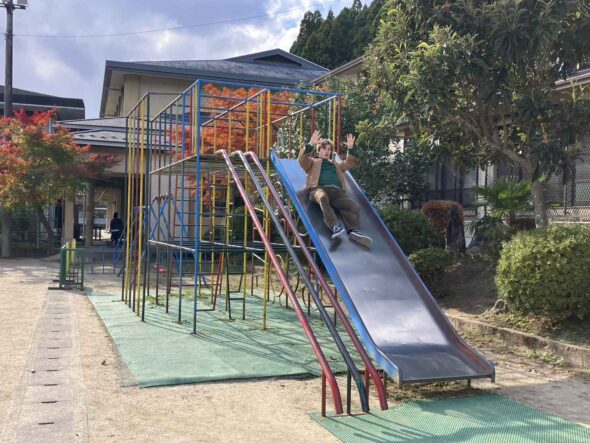
My CIP was as a English teaching assistant at Ohara Gakuin, a 1st-9th grade regional school just outside of Kyoto in the sleepy town of Ohara. I assisted the English teachers there along with my fellow KCJS student Sebastian as an English conversation partner with the students, as well as assisting in class lessons by providing a native perspective and native fluency. Ohara is a beautiful little town located in the northern mountains behind Kyoto, and every time I took the bus up there each week, I was astounded once again without fail of its natural beauty. The students there were very kind, and were very patient with my not-yet-fluent Japanese skills, and I ended up making a few connections that, I think, will be important memories for these students as they grow up– reminding them that there are friends and connections to be made with people regardless of their home country, language, appearance, et cetera. To incoming students, I would say that while you’re in Japan, try and engross yourself at least in some way in the everyday lives of Japanese people. Try to get outside of the 留学生 bubble at least a little bit, and immerse yourself, even if it’s hard, as putting yourself in something like a school setting, or a workplace setting, really helps you gain some valuable and unique cultural perspective on the everyday culture and activities of real Japanese people.
Chisom Akpom: Pottery Studio
During my time in Kyoto, I was able to participate in a local pottery studio for my CIP. They welcomed me even though I had no prior experience, and more than simply treating me with kindness, truly let me become a part of their family.
My teacher had a step-by-step plan for me to follow in order to advance in my pottery skills as a total beginner. In my few lessons there, I learned how to make a vase and a mug and designed them how I found fit. Not only did the lessons allow me to get a hang of the fundamentals, but I had total creative freedom and was supported by everyone around me to pursue anything that interested me that day. Although I started off shy and nervous, their warm nature made it easy for me to feel comfortable and eventually join in on their fun. Through the laughter and many jokes, I was able to not only better my intercultural competence, but learn from them how to live a better life.
To get the most of your experience, find ways you can connect with the people around you. If they mention something interesting, ask them about it. If you don’t understand their Japanese, be honest. While some CIPs don’t have much room for you to bond with the members, pottery made it easy because of the classroom’s nature: everyone sits around the same table with snacks and a drink, and speaks while they work. The more you speak, the closer you get, so make an effort to engage even if it scares you at first.
Steven Hadley: Volunteering at Bazaar Cafe
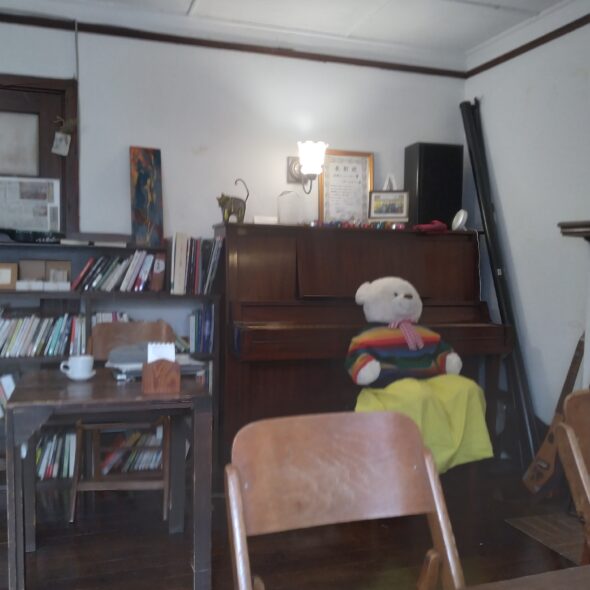
A cozy corner of the Bazaar Cafe, just to the right of the front counter, and to the left of the stone fire place.
At the Bazaar Cafe, I spent most of my time washing dishes and putting dishes away. When things were less busy, which happened semi-frequently, I was assigned to recycle old containers, or clean trays that had been used by customers. However, the unique atmosphere created by the diversity of experience, character, and age of all of the volunteers truly makes for a great group of people to work with, as well as chat with. People were very polite with me, in spite of my limited language skills, and wanted to make sure that I was comfortable during my time there. For those curious about volunteering at the Bazaar Cafe, I recommend doing your best to engage with others while on the job, and not being afraid to ask questions, whether they be work-related or not. The more you engage with the people around you in the kitchen, the more enriching your experience will feel, and the more supported you will feel in your work, and ultimately, as a member of the team.
Xinlan Chen: Volunteering at Kyoto Animal Care Center
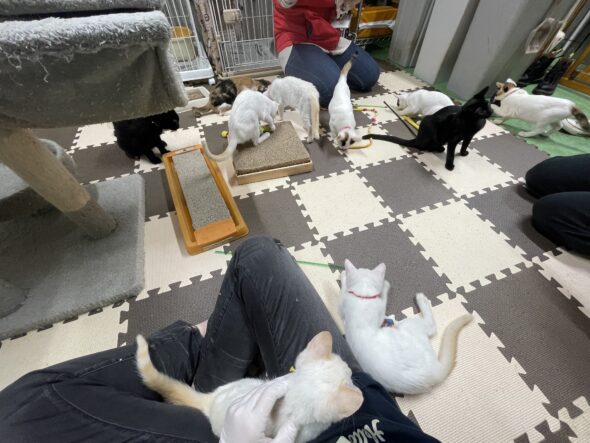
This semester, I am volunteering at Kyoto Animal Care Center for my Community Involvement Project. The center serves to help cats and dogs in need to connect with their prospective adopters, and we are there to help take care of them before they find their new home. Activities at the center includes taking the dogs out for walking, assisting with their training (teaching them to sit, wait, or to walk by the owner’s side, etc.), cleaning the dog pens, feeding the cats and cleaning their cages, and play with the cats to help them release their energy and get use to people. Once we were also invited to help create message cards for the household who’ve kindly adopted the kittens, using the photos of their new family member.
It was a very enjoyable and rewarding experience. To be able to work at the facility requires a decent level of Japanese skills as you’ll need to be able to communicate with the staffs and frequently changing volunteers working at the facility, and most of them are not skilled in communicating with foreigners or language learners and usually speaks fast & with accents. That being said, everyone at the center are all very nice and welcoming, and the animals are just ADORABLE, making volunteering at the center a wonderful experience and a great stress relief opportunity and a nice break from everyday class.
This opportunity is 100% recommended for whoever loves animals (you will not find any better place than here, esp. if you like kittens). Be somewhat prepared for needing a little time to fit in and for not being able to participate fully in their activities (taking care of some certain animals require more professional skills), but relax and do not feel stressed as all the staff and volunteers here are all very warm and understanding.
Chris Elson – Boxing
My CIP Activity was taking boxing lessons at a local private gym. While there, I could as many times as I wanted, given I paid for the month. Sessions usually started with a couple rounds of jump-rope, then shadow-boxing, punching bag, and finally a session of hitting the mitts with an instructor.
My experience was alright. I had never boxed before starting this CIP and I felt they were encouraging of me despite that fact. Still, I managed not to care too much for boxing and didn’t really care about going every week.
My advice to others would be that to just keep going. Regardless of skill level, you will gain respect the gym as long as you consistently show up. I was always weak, but I found towards the end that as I consistently attend, the better I would be treated, which honestly makes sense as its easy to build a better connection with the instructors and gym-goers at that point.
Torres Shi: Volleyball Circles


For myCIP project, I participated in volleyball circles for both the Fall and Spring semesters, In the Fall, I participated in two circles, called SANDLOT and L Volleyball, both of which are circles of the Doshisha University. In the Spring, I joined a new circle from Kyoto University of Molten Volleyball.
All three circles I was a part of had distinctive dynamics, and the level of skills also varied greatly. The two pictures below are from a tournament I participated in during the Fall semester and a regular practice session with the Molten Volleyball circle.
One advice from me would be to start conversations with new people actively. Japanese students are very friendly towards international students. However, they can be a little shy to start a conversation, so reach out to them and you will find that they are very easy and enjoyable to talk to.
Torres Shi: SANDLOT and L Volleyball Circles
Miggy Gaspar: Kyoto University Jogging Club
This semester, I joined the Jogging club at Kyoto University. When I was deciding on a CIP, I always knew that I wanted to do something involving a physical activity, and Jogging seemed like a natural fit. I was on the cross-country and track and field team in High School, so I was pretty confident that I would be able to keep up with the other members. However, I was a little anxious about how I’d get along socially. Thankfully, everyone in the jogging club was very welcoming and friendly towards me, and I’d often get dinner with them after practice.
I’d arrive Kyoto University about thirty minutes before practice so that I could talk with others before we ran. The room allocated for the club was this janky little shack out near the back entrance – a little dirty, but had a lot of charm. The people in the circle love playing mahjong – I’d often enter and find them in the middle of a competitive match, eyes glued to the tiles. Me personally, I had no idea what was going on; I know the basics of the game, but they were playing with a different rule set. Luckily, there’d be one or two people on the side that I could talk to, and they let me in on what was going on.
The Jogging itself was also pretty fun. Usually, we’d run 8-10 kilometers every practice I went. Our usual route was from Kyoto to University to along Kamogawa River, down to the road aligned with Kyoto Station, and then back. The club itself is comprised of members who both run competitively and for fun, so there were plenty of people in between that I could run alongside with. The runs were the most exhausting part of practice – trying to translate and talk at the same time I was running was both physically and mentally taxing. Most of the time, I’d wouldn’t say much save for the occasional comment. Afterwards, the club members would bring me to a great restaurant around school campus, which was the most rewarding part of the experience. I felt that I was able to talk more freely around the other members when we were eating together.
Overall, I’m really happy with my experience in the Jogging club. It was a great way to meet new people and utilize my Japanese. My advice to new students: make jokes about how Doshisha is worse than Kyoto University on your first day- if you play up that rivalry angle, I think you’ll make a positive impression.
